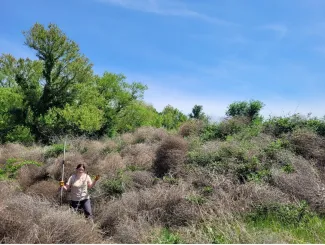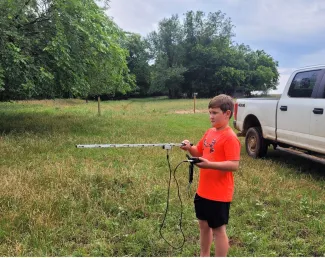
Turkey Researchers Report Evidence of Depredation
WILD TURKEY POPULATION DYNAMICS AND BROOD SURVIVAL PROJECT REPORT FOR MAY 2023
Provided by the Oklahoma Cooperative Fish and Wildlife Research Unit, Oklahoma State University
Wild turkey genetics, nesting success, and brood survival are among the research topics in a 4.5-year, $2 million study launched in 2022 by the Oklahoma Department of Wildlife Conservation, the Oklahoma Cooperative Fish and Wildlife Research Unit, other state and federal entities, and private landowners working together to address wild turkey population dynamics. Following is a summary of recent study activities.
SOUTHEASTERN OKLAHOMA POPULATION STUDY AREA: Team members continued monitoring radio-marked hens for nesting activity. Five mortalities (all attributed to predation) were confirmed during May for a total of 13 mortalities since January. The team is tracking and monitoring 29 hens. Ten new nests were found during May, bringing the total number to 18 for 2023. Of these 18 nests, 14 failed during incubation (six during April), two successfully hatched but have now failed, and two were being incubated at the end of May.
Researchers expected at least four poults to hatch, based on an egg count, in the first of the successful nests. Subsequently, the successful hatching of at least one poult was verified. The team attempted to capture the brood but were unable to locate any poults in the presence of the hen on the night of capture.
The second successful nest hatched May 19, with evidence of nine poults based on the presence of eggshells. The team conducted a capture the following morning and successfully tagged four poults. Unfortunately, on May 20, researchers confirmed the hen had been depredated along with her entire brood. Based on GPS data, the depredation event likely occurred the afternoon of May 20.
SOUTHWESTERN OKLAHOMA POPULATION STUDY AREA: The team continued monitoring radio-marked hens and recorded 10 nest initiations during May, with three being second attempts following previous failed attempts. Ten nests were lost during May, with all showing signs of depredation. The failed nests were incubated an average of 5.3 days (range: 1–12 days). All egg remains were swabbed for e-DNA to determine predator species.
Researchers relocated three transmitter-carrying hens during May, two of which were confirmed dead. In total, five tracked hens perished during May, with three of those deaths attributed to predation and two to unknown causes. All perished hens’ transmitters were retrieved and swabbed for e-DNA to determine predator species.
At the end of May, researchers were tracking and monitoring 18 hens in the southwest, five of which were actively incubating. In early May, the team completed deployment of 50 game cameras for predator density estimates.
GENETICS STUDY: Researchers and partners from across Oklahoma have collected 140 tissue samples in 2023. Teams have also collected about 60 blood samples from turkeys captured at study sites this year. All collected samples are currently being processed for DNA extraction, and all samples will be sent for next-generation sequencing at the end of June, with results expected by early fall.
(Financial support for this publication was provided by the Oklahoma Department of Wildlife Conservation through the Wildlife Restoration Program, F21AF02702 [W-216-R-1] and Oklahoma State University.)
